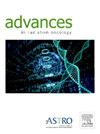Magnetic Resonance Imaging Radiomic Analysis of Radiation-Induced Morphea of the Breast: A Proof-of-Concept Study
IF 2.7
Q3 ONCOLOGY
引用次数: 0
Abstract
Purpose
Radiation-induced morphea (RIM) is a very rare but devastating side effect of breast radiation therapy, characterized by progressive skin induration, pain, and discoloration, with no effective treatments currently available. This is a proof-of-concept study that aims to identify radiomic features from pretreatment magnetic resonance imaging (MRI) scans associated with the development of RIM in patients with breast cancer undergoing radiation therapy.
Methods and Materials
This is a retrospective analysis of a single institutional registry of patients who received diagnosis of RIM following breast radiation therapy from 2008 to 2022. Clinical and histopathological data were reviewed. Pretreatment MRI scans of these patients and matched controls were analyzed. Radiomic features were extracted from whole breast and fibroglandular tissue regions of interest. A total of 528 radiomic features were compared between patients who developed RIM and those who did not, using the Wilcoxon rank-sum test to identify statistically significant differences.
Results
We evaluated 10 patients who received clinical diagnosis of RIM, with a mean age of 63 years (range, 44-75 years). Among these, 7 patients had biopsy-proven RIM. Both clinical and histologic findings were correlated with radiomic analyses. Forty percent of the patients had a history of autoimmune disorders, including hypothyroidism, Graves’ disease, systemic sclerosis, and systemic lupus erythematosus. Radiomic analysis identified 11 significant features, primarily related to tissue structure and texture. Nine of these features were from the contralateral breast, and 2 were from the ipsilateral breast.
Conclusions
This is a pilot study on a small sample that demonstrates that radiomic features extracted from pretreatment MRI scans can serve as potential predictors for the development of RIM in patients with breast cancer. The integration of clinical and histopathological data with radiomic analysis highlights the distinct changes in breast tissue architecture that precede RIM onset. These findings pave the way for the early identification of patients at risk, allowing for more personalized surveillance and management strategies.
磁共振成像放射学分析辐射引起的乳房睡眠:一项概念验证研究
目的:放射诱导的皮肤坏死(RIM)是乳房放射治疗中一种非常罕见但具有破坏性的副作用,其特征是进行性皮肤硬化、疼痛和变色,目前尚无有效的治疗方法。这是一项概念验证性研究,旨在确定预处理磁共振成像(MRI)扫描与接受放射治疗的乳腺癌患者RIM发展相关的放射学特征。方法和材料本研究是对2008年至2022年接受乳房放射治疗后诊断为RIM的单一机构登记患者的回顾性分析。回顾了临床和组织病理学资料。分析了这些患者和匹配对照的预处理MRI扫描结果。从整个乳房和感兴趣的纤维腺组织区域提取放射学特征。采用Wilcoxon秩和检验,对发生RIM的患者和未发生RIM的患者进行了528项放射学特征的比较,以确定具有统计学意义的差异。结果我们评估了10例临床诊断为RIM的患者,平均年龄63岁(44-75岁)。其中7例经活检证实为RIM。临床和组织学结果均与放射组学分析相关。40%的患者有自身免疫性疾病史,包括甲状腺功能减退、格雷夫斯病、系统性硬化症和系统性红斑狼疮。放射组学分析确定了11个重要特征,主要与组织结构和质地有关。其中9例来自对侧乳房,2例来自同侧乳房。结论:这是一项小样本的试点研究,表明从预处理MRI扫描中提取的放射学特征可以作为乳腺癌患者RIM发展的潜在预测因素。临床和组织病理学数据与放射组学分析的整合突出了RIM发病前乳腺组织结构的明显变化。这些发现为早期识别有风险的患者铺平了道路,允许更个性化的监测和管理策略。
本文章由计算机程序翻译,如有差异,请以英文原文为准。
求助全文
约1分钟内获得全文
求助全文
来源期刊

Advances in Radiation Oncology
Medicine-Radiology, Nuclear Medicine and Imaging
CiteScore
4.60
自引率
4.30%
发文量
208
审稿时长
98 days
期刊介绍:
The purpose of Advances is to provide information for clinicians who use radiation therapy by publishing: Clinical trial reports and reanalyses. Basic science original reports. Manuscripts examining health services research, comparative and cost effectiveness research, and systematic reviews. Case reports documenting unusual problems and solutions. High quality multi and single institutional series, as well as other novel retrospective hypothesis generating series. Timely critical reviews on important topics in radiation oncology, such as side effects. Articles reporting the natural history of disease and patterns of failure, particularly as they relate to treatment volume delineation. Articles on safety and quality in radiation therapy. Essays on clinical experience. Articles on practice transformation in radiation oncology, in particular: Aspects of health policy that may impact the future practice of radiation oncology. How information technology, such as data analytics and systems innovations, will change radiation oncology practice. Articles on imaging as they relate to radiation therapy treatment.
 求助内容:
求助内容: 应助结果提醒方式:
应助结果提醒方式:


